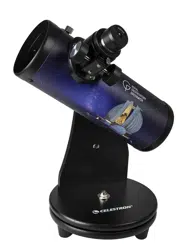Loading ...
Loading ...
Loading ...

6 | ENGLISH
Unlike fixed targets on the ground, astronomical targets
move across the sky. This is caused by Earth’s rotation.
When you observe a celestial target in your telescope,
such as the Moon or planets, it will appear to slowly drift
across the field of view of your eyepiece. The higher the
magnification of your eyepiece, the faster the object will
appear to drift. In order to keep the object centered in the
field of view, you will have to nudge the mount in altitude and
azimuth. To maximize your viewing time between nudges,
watch the target drift across the field of view to see what
direction it is heading. Try to position the scope just ahead
of it, and then watch as the target drifts into the field of view
from one side and exits the other.
Your telescope will magnify objects and make them appear
much closer than they are. As you increase magnification
on the Moon, you will see details within the craters and
mountain ranges. Planets such as Jupiter and Saturn will
increase from a small point of light to a noticeable disk.
Stars, on the other hand, will not increase in size, no matter
how powerful an eyepiece you use. Why? Stars are too far
away to be resolved as a sphere. If you could bring them
250 times closer by using a very high power eyepiece, stars
would still only appear as a pinpoint of light, even through
large professional telescopes. However, your telescope
will show you the separation between double stars. Some
deep-sky objects, such as the Orion Nebula, may look
like stars to the naked eye, but under magnification, it will
appears as a large “fuzzy” cloud through your telescope.
APPARENT MOTION OF THE SKY
MAGNIFICATION AND STARS
WHAT TO EXPECT WITH
YOUR NEW TELESCOPE
Celestial objects can vary dramatically in brightness.
Astronomers use a scale called “apparent magnitude” to
compare the relative brightness of these objects. The star
Vega, in the constellation Lyra, serves as the baseline to
which all other objects are compared. Vega is considered
to have a brightness of magnitude 0. Though it may
seem counterintuitive, as the brightness of a star or other
celestial object increases, its number on the magnitude
scale decreases. According to this scale, the Sun has
the greatest brightness with a magnitude of -27, while the
faintest stars the unaided human eye can detect under
perfect dark conditions are magnitude 6.
The limit to what the unaided human eye can see varies
depending on the size of your iris (the opening of your eye).
The average adult human iris can only open about 7 mm
when fully dark-adapted. Astronomers use telescopes with
larger apertures to collect more light and focus it to a point
that can enter the 7 mm iris of your eye, allowing you to
not only see more detail, but fainter detail than you would
otherwise. The larger the aperture of your telescope, the
more detail you can see.
The first targets you should consider finding are the bright
ones. As you gain familiarity with your telescope, you can
start looking for fainter objects.
RELATIVE BRIGHTNESS OF OBJECTS
Loading ...
Loading ...
Loading ...
